What is pancetta? Basically, it is the unsmoked Italian form of bacon. Bacon is almost always smoked and has a salty taste, but sometimes it has a sweet and/or peppery taste as well. Pancetta is also always salty but not traditionally smoky.
You might be asking “Why on earth would I want to make my own pancetta”? Let me attempt to sway you with some of my own reasons.
More personal to me is that I am on a mission to perfect and teach techniques that we don’t currently teach at The Chopping Block. Charcuterie is one skill we don’t teach much… the total curing time it takes to make the pancetta doesn’t make it possible to teach it in our regular classes. However, making pancetta is not a very involved process nor does it require much in the way of special equipment and ingredients. If you love to cook and experiment, making something as cool as pancetta might be irresistible!
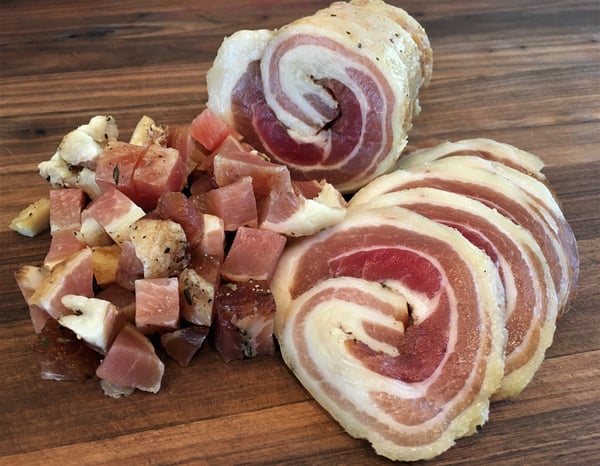
I was never a huge fan of pancetta until making my own. I have always felt it was relatively bland and earthy in a way I never liked that much. But how could pork belly and spices be that bad? Plus Italians love it, and they know delicious food!
Pancetta’s seasonings can change, but nutmeg, juniper and black pepper are pretty standard. I highly encourage you to change up the spices and adapt the recipe to your taste or to compliment the flavors of the dish you plan to use it in. These recipes are based on more traditional Italian flavors but you could easily make a Mexican, Japanese or Korean influenced Pancetta! These recipes are based off of Michael Ruhlman's recipe in his amazing book Charcuterie by Ruhlman and Brian Polcyn. If you get the charcuterie bug after trying to make pancetta, I would highly recommend this book!
What you will need
The main ingredient is pork belly. You can purchase pork belly online, but it can be expensive. Any local butcher can order you some or you can get it from a local farmer. The pork belly from the butcher will likely be thinner than from a farmer. Note that the thinner the pork belly, the faster it will cure. A slab is generally about 3 to 5 pounds.
You will also need #1 curing salt which may be harder to find locally, but something you can easily order online. Curing salt has the nitrates you need for taste and color, if you have a problem with using nitrates you can eliminate it, but it will change the color and flavor.
You will also need twine to tie up the pancetta into the traditional roll as well as a Microplane grater or a nutmeg grater. Fresh nutmeg has a very bright taste and is far less musty than the ground version. I would highly recommend using it in such a hand-crafted recipe as pancetta.
What is curing?
The first step in making pancetta is curing the pork belly. In the curing process, you are in fact, cooking the pork belly in salt. Cooking does not always require heat, it can be done through multiple methods, including curing. I don’t want to get too deep into the details, but I like to describe the general process of cooking as the removal of moisture from food. Curing is a very old method of cooking and one of the best for preserving food. Modern curing methods use much less salt, because we don’t need to preserve our food in the same way as the settlers did. So to improve the flavor of the food, we use far less salt these days. The salt is generally combined with other seasonings to impact more complex flavors into the meat. As the meat cures, it expels its liquids and is imparted with the flavors of the cure.
The Cure Recipe
4 garlic cloves, chopped roughly (unless you like a lot of garlic flavor and then mince)
2 teaspoons #1 curing salt
1/4 cup kosher salt
2 tablespoons light brown sugar
4 tablespoons cracked black pepper
4 bay leaves, crumbled
1 teaspoon freshly grated nutmeg
4 or 5 sprigs fresh thyme
Optional, chose 1 or none:
1 teaspoon whole allspice, cracked in half with the back of a pan
1 teaspoon fennel seeds
1 cinnamon stick, cracked with the back of a pan until it likely in about 10 little pieces or so
2 tablespoons juniper berries, cracked with the back of a pan
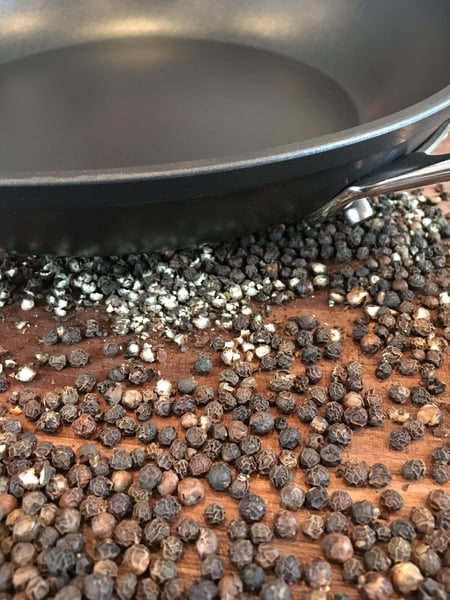
The Steps
1. Remove the skin from the pork belly and cut it in half. The pork belly is generally pretty square and I don’t care if it is perfectly square so I don’t trim it further, if you care that the pancetta will be a very uniform shape then trim it here into an even square. You may want to ask your butcher to remove the skin if you don’t have a really sharp knife, and some confidence with it. It is really the same method to remove the pork skin as I use for skinning a fish.
I’m sorry I don't have a video of skinning the pork belly, but I will make one and add it to the instructions. Save the skin, because you can freeze it and try making chicharrones!
2. Rub the cure on all sides of the two pieces and put the pieces and all the cure in a sealed plastic bag. Make sure to squeeze out all of the air and put the bag in a non-reactive container, in case it leaks. Put the pork belly in the fridge for 5 to 7 days. Turn the bag over every couple of days to redistribute the cure. The meat will be firm when it is done but not rock hard, after all it is a belly!
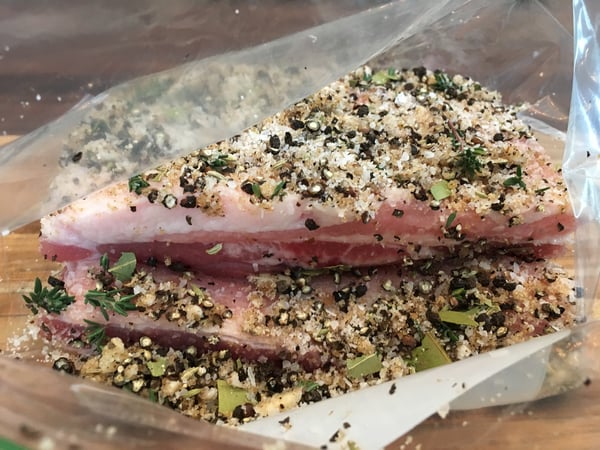
3. Rinse off all the cure and spices. If a few bits of spices are left it’s no big deal, just make sure you would want to eat whatever is left.
4. I like to set it in the fridge for a day to let the surface dry off completely. I think it is easier to get a really tight roll when you do this. If you are anxious to roll it, just dry the meat off very well.
5. Crack black pepper so that it is evenly covering what will be the interior of the pancetta roll.
6. Cut a piece of twine that is about 6 times the size of the pork belly. I’m going to skip the description on how the use the twine… just refer to this video.
7. I have an old wine fridge I am using to hang the pancetta. You certainly don’t need this, you can just put the pancetta on a plate and uncovered leave it in the fridge for 2 weeks.
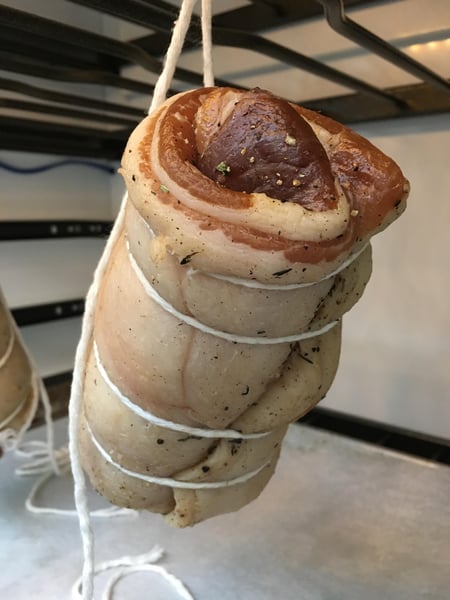
The pancetta is edible right out of the cure so don’t worry about how to tell when it is done, you could use it right away. The 2 weeks allows more moisture to evaporate which concentrates the flavor and also helps the pancetta roll to adhere even when you remove the twine.
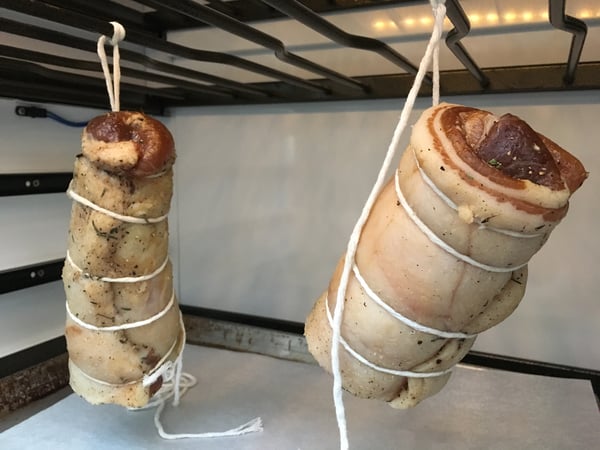
8. The pancetta will keep for weeks now, but you can also freeze it and it will last for months.
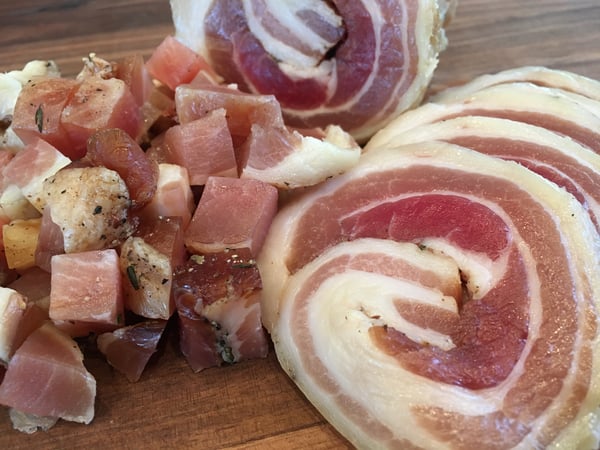
Pancetta Recipes
Come back for my blog next month, and I will show you some recipes highlighting pancetta, including the classic Carbonara pasta!
While we may not have a class on making pancetta, we do offer a great one on homemade sausage called Sausage Party coming up on Saturday, May 26 at Lincoln Square. You'll learn how to prepare forcemeat, work with sausage casings and sausage stuffing tools, work with spices and make meat emulsions. It's the perfect class for the charcuterie lover!











